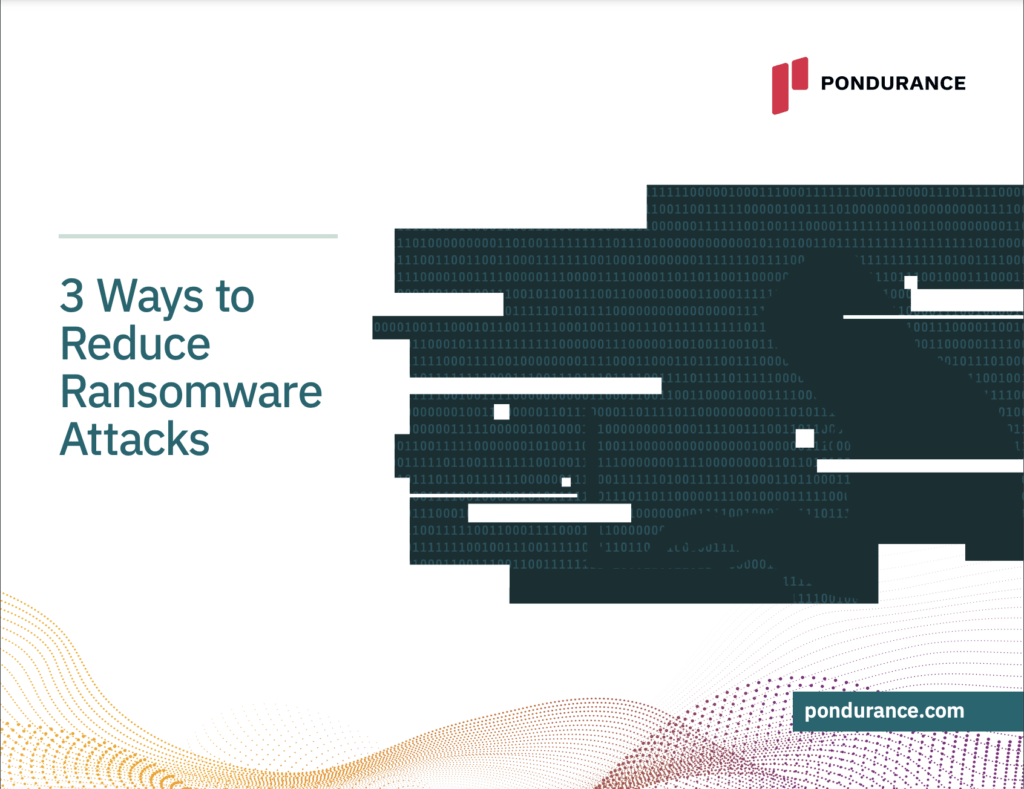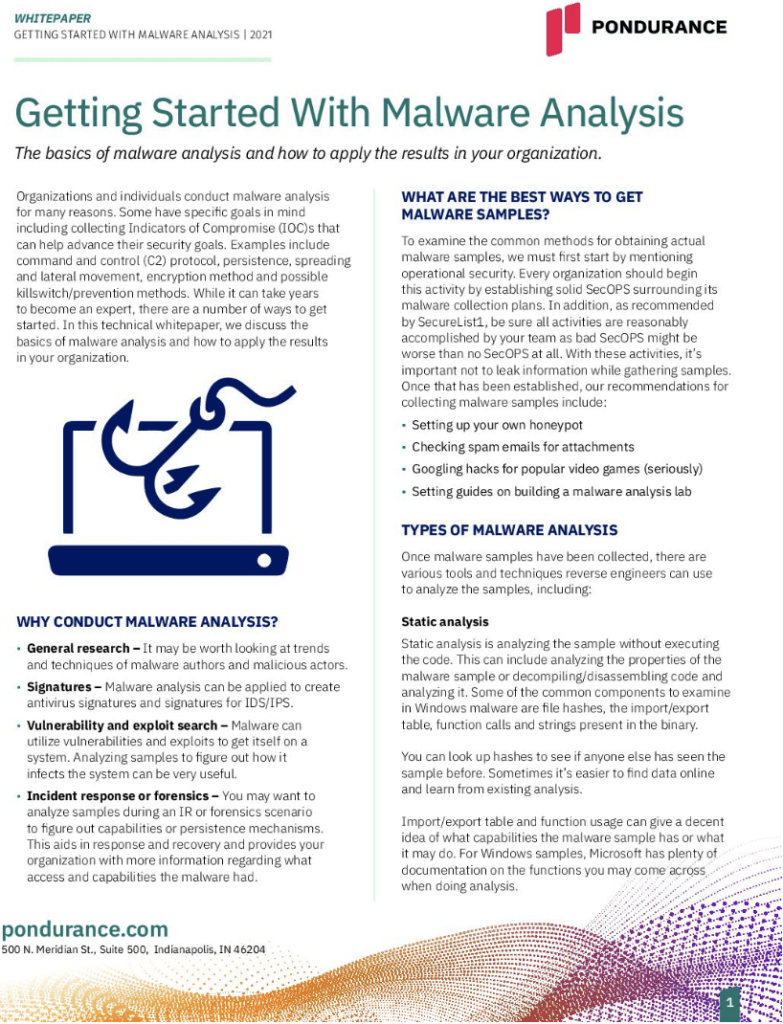Our privacy policy is located here.
Common Attack Vectors
And Keys to Protecting Your Business
Ransomware
- Keep all computers and devices patched
- Enable MFA
- Limit user access
- Allow only authorized applications
- Use network segmentation
- Limit remote access as much as possible
- Establish 360-degree visibility
- Monitor and analyze logs
- Provide consistent security awareness training
- Encrypt endpoints
Identify. Prioritize. Protect.
Malware
- Install reputable antivirus software and ensure it remains up to date
- Regularly update your operating system and all installed applications
- Enable built-in firewalls on your devices
- Be cautious of email attachments and links from unknown sources
- Utilize strong passwords and enable multifactor authentication (MFA) where possible
- Create regular backups of your important files and store them securely offsite
- Employee training – Educate staff members about potential threats such as phishing emails and social engineering tactics employed by cybercriminals
- Network segmentation – Divide your organization’s network into separate zones to minimize the spread of malware should an attack occur
- Vulnerability management – Regularly assess, identify, and remediate vulnerabilities in your IT infrastructure before they can be exploited by attackers
- Incident response planning – Develop a well-defined incident response plan outlining roles, responsibilities, and procedures to follow when faced with a security breach
Phishing
Additional Phishing Resources
Spear Phishing
Additional Spear Phishing Resources
Business Email Compromise (BEC)
Additional BEC Resources
What is Ransomware
Ransomware poses a significant threat to organizations of all sizes, making it imperative for cybersecurity teams to stay vigilant and proactive in their cyber risk management efforts. Informed security measures are crucial for mitigating the potential impacts of ransomware attacks and safeguarding sensitive data from falling into the wrong hands. Top cybersecurity companies emphasize the importance of threat intelligence and cyber threat assessments to bolster their security posture and preemptively identify potential threats.
Cyber risk reduction strategies involve comprehensive vulnerability management and regular risk assessments to identify and address weaknesses in information systems before they can be exploited by malicious actors. By implementing a robust risk management strategy, organizations can strengthen their defenses against cyber threats and minimize the likelihood of data breaches occurring. Additionally, fostering a culture of cybersecurity awareness among employees is essential for enhancing overall security posture and reducing the risk of human error leading to security incidents.
As ransomware attacks continue to evolve in sophistication and frequency, proactive measures such as regular security audits, penetration testing, and employee training are paramount for staying one step ahead of cybercriminals. By staying abreast of emerging cybersecurity threats and implementing proactive security measures, organizations can effectively mitigate the risk of falling victim to ransomware attacks and ensure the integrity and confidentiality of their sensitive data.
Understanding Ransomware
Understanding ransomware is crucial in today’s digital world, as it poses significant threats to organizations and individuals alike. By comprehending its inner workings, one can take the necessary steps to protect their valuable data and mitigate risks associated with this ever-evolving form of cyberattack. There are various types of ransomware attacks, each with distinct characteristics and methods of operation.
Some common forms include crypto ransomware, locker ransomware, and scareware. Crypto ransomware encrypts the victim’s files, rendering them inaccessible unless a ransom is paid for the decryption key. Locker ransomware locks the user out of their device entirely rather than targeting specific files. Scareware often impersonates legitimate security applications or law enforcement agencies to intimidate victims into paying a “fine” to regain access to their system or remove supposed malware.
When analyzing how does ransomware work, it is essential to grasp the typical stages: infection, communication, encryption, and extortion. Ransomware typically infiltrates a system through malicious email attachments or infected websites. Once inside the network, it communicates with its command-and-control server to receive an encryption key before encrypting files on the victim’s device using robust cryptography algorithms. Upon successful encryption completion, attackers demand payment in exchange for the decryption key – often in cryptocurrency like Bitcoin – hence the term “ransom.”
Understanding ransomware goes beyond just grasping its functioning; it also entails acknowledging that these attacks are motivated by financial gain for cybercriminals who exploit vulnerabilities in an organization’s cybersecurity posture. In some instances, other motives such as political activism or revenge may play a role.
Conducting a thorough ransomware risk assessment can help organizations identify areas where they may be susceptible to attack while highlighting existing cybersecurity weaknesses that need addressing. This process involves evaluating all relevant aspects, such as employee awareness training programs on phishing techniques used by attackers and updating antivirus software regularly. Recognizing different types of ransomware attacks, their modus operandi, and motivations can help organizations implement more robust security measures. For example, Crypto ransomware can be mitigated by having a comprehensive backup strategy in place that ensures critical data is stored securely and regularly updated.
In the case of locker ransomware, implementing access controls and network segmentation can limit the attacker’s reach within the system. For scareware, it’s crucial to educate users about recognizing fake applications or pop-ups and not falling victim to intimidation tactics. Moreover, having a multifaceted approach to cybersecurity that includes human intelligence alongside AI and automation is essential for detecting and responding to these attacks adequately.
Attackers are often innovative individuals who continuously adapt their methods to bypass security measures; thus, employing ingenious human experience alongside advanced technological solutions is necessary for timely detection and response. By combining efforts like Pondurance’s advanced platform with the expertise gathered from decades of human intelligence, organizations can efficiently contain cybersecurity threats while minimizing overall risk exposure.
Gaining a complete understanding ransomware enables organizations to appreciate the potential danger it poses in today’s digital landscape. By grasping its workings and various types of attacks, they can proactively take steps toward preventing them from occurring or minimizing damage if they do happen. Ultimately, having informed knowledge of ransomware will empower better decision-making when securing valuable data against this ever-growing threat.
How to Prevent Ransomware Attacks
Ransomware attacks have become an increasingly prevalent issue in the world of cybersecurity. This malicious software encrypts a victim’s data and holds it hostage until a ransom is paid. These attacks are no longer limited to large organizations but also target small businesses, individuals, and even local government entities. It is essential to understand how to prevent ransomware attacks and have a comprehensive ransomware incident response plan in place.
One critical factor for preventing ransomware attacks involves maintaining regular backups of your important files, systems, and databases. This step ensures that even if your information is encrypted during an attack, you can recover from it without paying the demanded sum. Implementing robust security measures such as firewalls, antivirus software, and intrusion detection systems can also go a long way toward protecting against ransomware.
A well-thought-out ransomware incident response plan should outline the steps your organization must take when faced with a potential attack. This includes identifying the infected machines or networks, containing the damage by isolating them from other networks or devices and eliminating the threat through various means such as restoring from backup or decrypting files using available tools.
Ransomware attack prevention goes hand-in-hand with employee education and training. Informing staff about common phishing techniques used by cybercriminals can significantly reduce the risk of falling victim to an attack. Employees should be aware of how to report suspicious activity or identify potential threats before they escalate into full-blown incidents. To protect against ransomware effectively, organizations should adopt a multi-layered security approach encompassing proactive measures such as vulnerability scanning and patch management alongside reactive measures like incident response planning and disaster recovery strategies.
Creating a thorough ransomware playbook ensures that organizations are prepared for various scenarios involving this type of cyber threat. A comprehensive playbook should address aspects such as threat intelligence gathering, detection methods, containment strategies, eradication techniques, recovery processes, and lessons learned from previous incidents. The importance of following specific ransomware incident response steps cannot be overstated. An effective response should begin with assessing the situation to determine the scope of the attack and potential damage. Next, containment measures are implemented to prevent further spread of the ransomware.
Once contained, efforts must focus on eradicating the threat and recovering from its effects. A thorough incident analysis should lead to actionable insights for improving future prevention and response efforts. In conclusion, ransomware attacks pose a significant risk to businesses and individuals alike. Through proactive defense measures such as regular backups, employee training, and robust security protocols, organizations can minimize their exposure to these threats.
Additionally, having a comprehensive ransomware incident response plan in place is crucial for timely detection and containment of attacks – mitigating potential damages and disruptions. Utilizing expert resources like Pondurance can be invaluable for enhancing your organization’s cybersecurity posture against ransomware attacks. By combining cutting-edge technology with human intelligence, Pondurance provides tailored solutions designed to detect and respond effectively to cyber threats in today’s increasingly complex digital landscape.
By taking these preventative measures and incorporating them into a comprehensive cybersecurity strategy, organizations can significantly reduce their vulnerability to ransomware attacks – ultimately safeguarding critical data assets while maintaining operational continuity in an increasingly interconnected world. To find out how security solutions from Pondurance help defend against ransomware, request a demo today.
Related Topics
- Mdr Consultant
- What Is Incident Response
- Mdr Solution
- How To Prevent Ransomware Attacks
- What Is Mdr
- What Is Managed Detection And Response
- Mdr Services
- Managed Detection And Response
- Mdr Cybersecurity
- What Is Mdr In Cybersecurity
- Spear Phishing
- Cyber Incident Response
- Threat Hunting
- How To Protect Against Ransomware
- Phishing Attack
- Endpoint Detection And Response
- What Is Malware
- Security Operations Center

